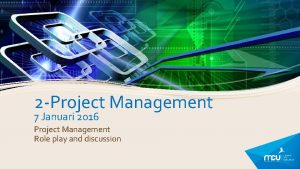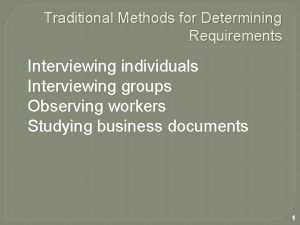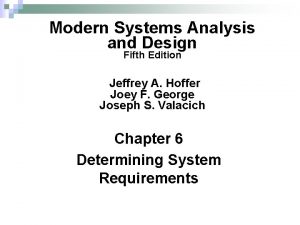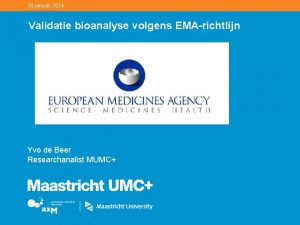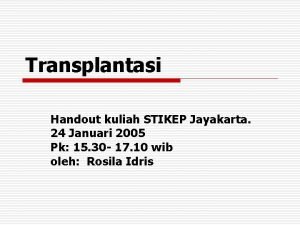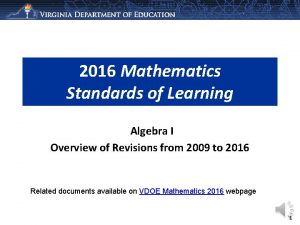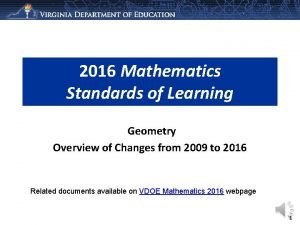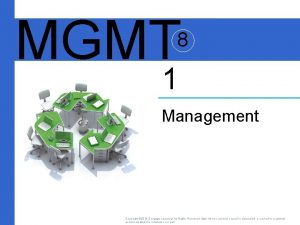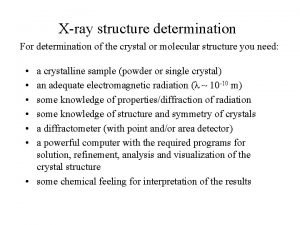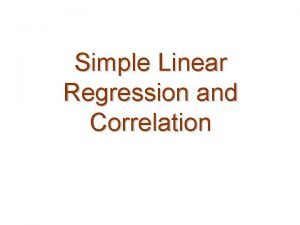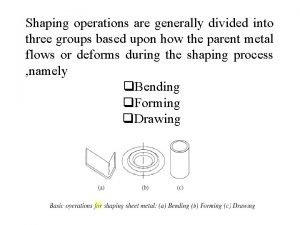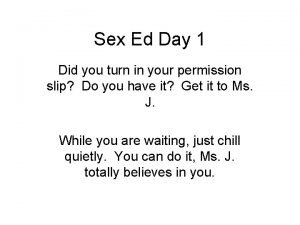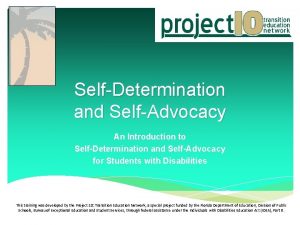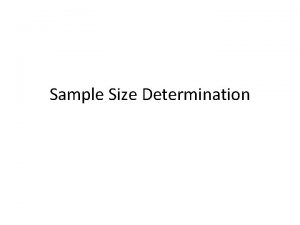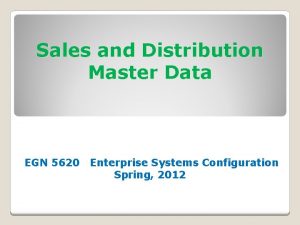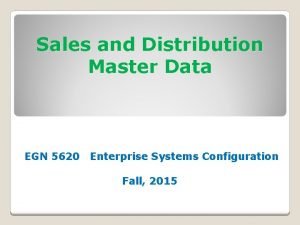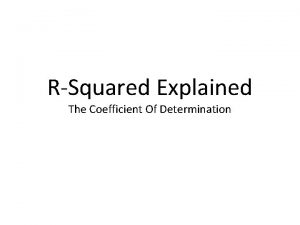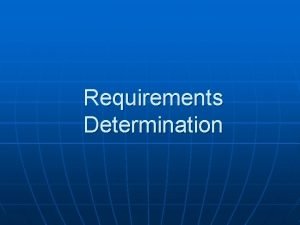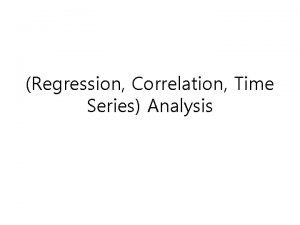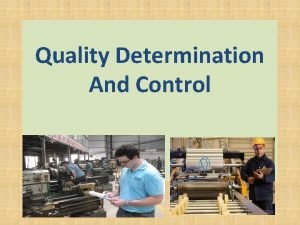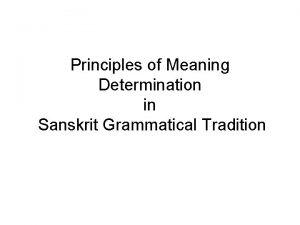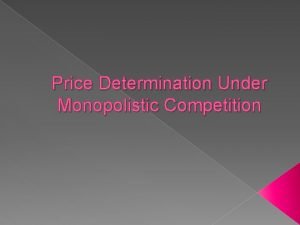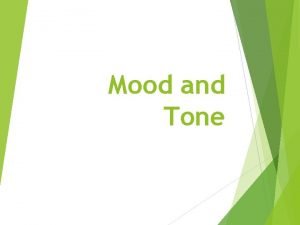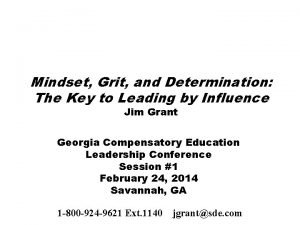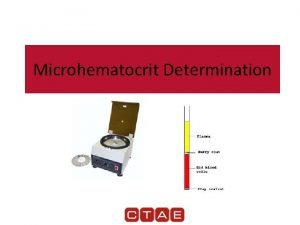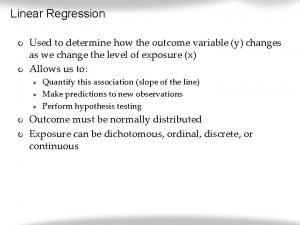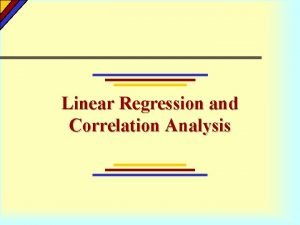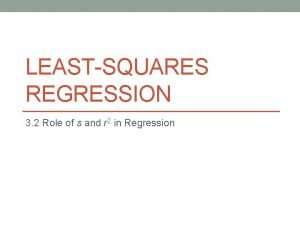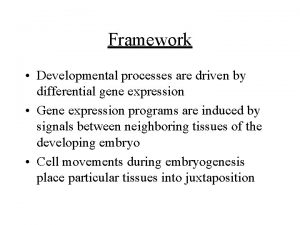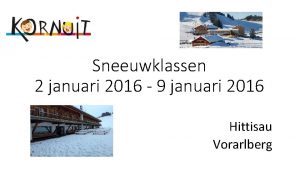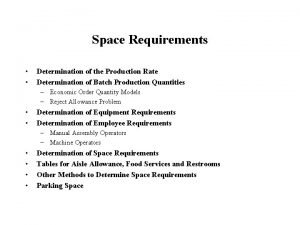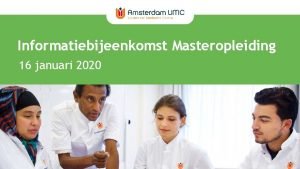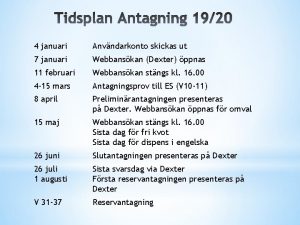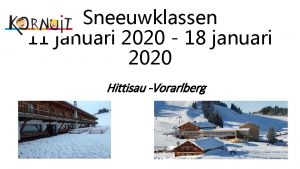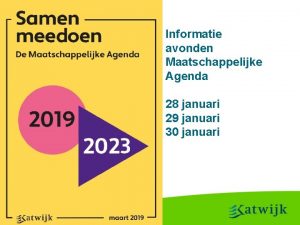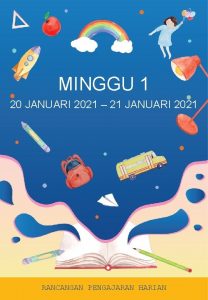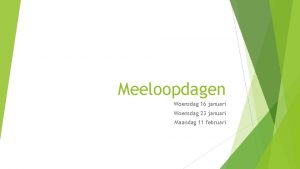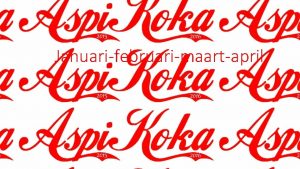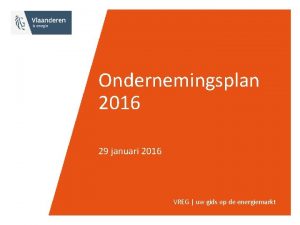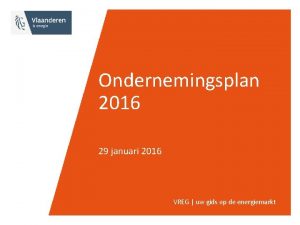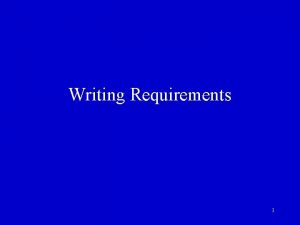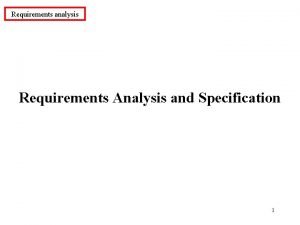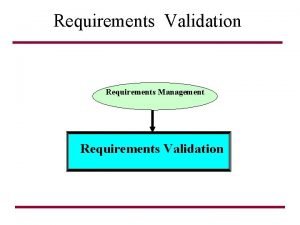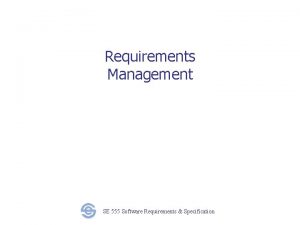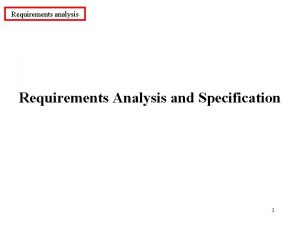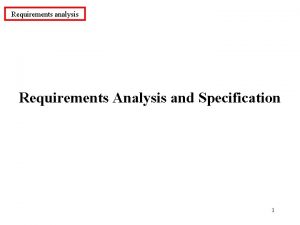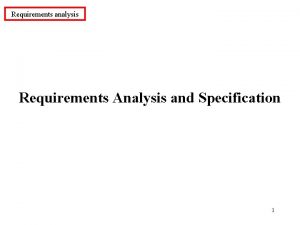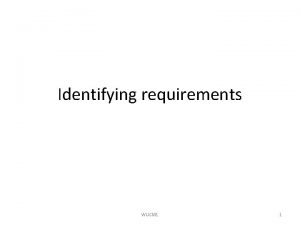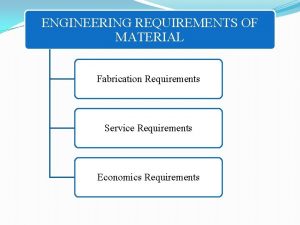11 Januari 2016 Chapter 4 Requirements Determination Learning

































- Slides: 33

11 Januari 2016 Chapter 4: Requirements Determination

Learning Objectives • • Learn how to create a requirements definition Learn various requirements analysis techniques Learn when to use each requirements analysis techniques Learn how to gather requirements using interviews, JAD sessions, questionnaires, document analysis & observation Learn various requirements documentation techniques such as concept maps, story cards & task-lists Understand when to use each requirements-gathering technique Be able to begin the creation of a system proposal

Introduction • The systems development process transforms the existing (as is) system into the proposed (to be) system • Requirements determination The single most critical step of the entire SDLC • Changes can be made easily in this stage • Most (>50%) system failures are due to problems with requirements • The iterative process of OOSAD is effective because: • Small batches of requirements can be identified and implemented incrementally • The system will evolve over time •

Requirements Determination Purpose: to convert high level business requirements (from the system request) into detailed requirements that can be used as inputs for creating models • What is a requirement? • A statement of what the system must do or a characteristic it must have • Will later evolve into a technical description of how the system will be implemented • • Types: Functional: relates to a process or data • Non-functional: relates to performance or usability •

Nonfunctional Requirements Requirement type Example Operational • The system should be able to fit in a pocket or purse • The system should be able to integrate with the existing inventory system. Performance • Any interaction between the user and the system should not exceed 2 seconds. • The system should receive updated inventory information every 15 minutes. Security • Only direct managers can see personnel records of staff • Customers can see their order history only during business hours. Cultural & Political • The system should be able to distinguish between United States and European currency • The system shall comply with insurance industry standards.

Requirements Definition Functional & non-functional requirements listed in outline format • May be prioritized • Provides information needed in subsequent workflows • Defines the scope of the system •

Determining Requirements Business & IT personnel need to collaborate • Strategies for effective results: • Business Process Automation (BPA) • Business Process Improvement (BPI) • Business Process Reengineering (BPR) •

Determining Requirements are best determined by systems analysts and business people together • Strategies for analyzing the requirements • Business Process Automation (BPA) • Business Process Improvement (BPI) • Business Process Reengineering (BPR) • Techniques for identifying requirements • Interviews, questionnaires and/or observation • Joint application development (JAD) • Document analysis •

Creating a Requirements Definition • • • Determine the types of functional and non-functional requirements applicable to the project Use requirements-gathering techniques to collect details Analysts work with users to verify, change and prioritize each requirement Continue this process through analysis workflow, but be careful of scope creep Requirements that meet a need but are not within the current scope can be added to a list of future enhancements

Problems in Requirements Determination • Analyst may not have access to the correct users • Requirements specifications may be inadequate • Some requirements may not be known in the beginning • Verifying and validating requirements can be difficult

Requirements Analysis Strategies Business Process Automation (BPA) • Least amount of change to the current system • Use computer technology to automate some portions • Business Process Improvement (BPI) • Moderate amount of change is required • Designed to improve efficiency of the current system • Business Process Reengineering (BPR) • Most amount of change—a complete makeover • Focus is on the to-be system—little time spent on the current system •

Business Process Automation • Techniques • Problem analysis Ask users to identify problems with the current system • Ask users how they would solve these problems • Good for improving efficiency or ease-of-use • • Root cause analysis Focus is on the cause of a problem, not its solution • Create a prioritized list of problems • Try to determine their causes • Once the causes are known, solutions can be developed •

Business Process Improvement • Techniques: • Duration analysis Determine the time required to complete each step in a business process • Compare this to the total time required for the entire process • Large differences suggest problems that might be solved by: • • Integrating some steps together • Performing some steps simultaneously (in parallel) Activity-based costing—same as duration analysis but applied to costs • Informal benchmarking—analyzes similar processes in other successful organizations •

Business Process Reengineering Institutes maximum change: “Out with the old and in with the new” • Techniques: • Outcome analysis—what does the customer want in the end? • Technology analysis—apply new technologies to business processes & identify benefits • Activity elimination—eliminate each activity in a business process in a “force-fit” exercise •

Selecting An Appropriate Strategy

Requirements Gathering Techniques • Process is used to: Uncover all requirements (those uncovered late in the process are more difficult to incorporate) • Build support and trust among users • • Which technique(s) to use? • • • Interviews Joint Application Development (JAD) Questionnaires Document analysis Observation

Interviews Most popular technique—if you need to know something, just ask • Process: • • • Select people to interview & create a schedule Design interview questions (Open-ended, closed-ended, & probing types of questions) Prepare for the interview (Unstructured vs. structured interview organized in a logical order) Conduct the interview (Top-down vs. bottom-up) Follow-up after the interview

Question Types

Interviewing Strategies Top-down High-level: Very general How can order processing be improved? How can we reduce the Medium-level: Moderately specific number of times that customers return ordered items? Low-level: Very specific How can we reduce the number of errors in order processing (e. g. , shipping the wrong products)? Bottom-up

Post-Interview • Prepare notes and send to the interviewee for verification

Joint Application Development (JAD) • Joint user-analyst meeting hosted by a facilitator 10 to 20 users • 1 to 2 scribes as needed to record the session • Usually in a specially prepared room • • Meetings can be held electronically and anonymously Reduces problems in group settings • Can be held remotely • • Sessions require careful planning to be successful Users may need to bring documents or user manuals • Ground rules should be established •

Questionnaires A set of written questions used to obtain information from individuals • May be paper based or electronic (e. g. , web based) • Common uses: • Large numbers of people • Need both information and opinions • When designing for use outside the organization (customers, vendors, etc. ) • Typical response rates: < 50% (paper); < 30% (Web) •

Questionnaire Steps • Select the participants • • • Designing the questionnaire • • • Careful question selection Remove ambiguities Administering the questionnaire • • • Identify the population Use representative samples for large populations Working to get good response rate Offer an incentive (e. g. , a free pen) Questionnaire follow-up • • Send results to participants Send a thank-you

Good Questionnaire Design • • • Begin with non-threatening and interesting questions Group items into logically coherent sections No important items at the very end Do not crowd a page with too many items Avoid abbreviations Avoid biased or suggestive items or terms Number questions to avoid confusion Pretest to identify confusing questions Provide anonymity to respondents

Document Analysis Provides information about the “as-is” system • Review technical documents when available • Review typical user documents: • Forms • Reports • Policy manuals • Look for user additions to forms • Look for unused form elements •

Observation Users/managers often don’t remember everything they do • Checks validity of information gathered in other ways • Behaviors may change when people are watched • Workers tend to be very careful when watched • Keep a low profile • Try not to interrupt or influence workers • • Be careful not to ignore periodic activities • Weekly … Monthly … Annually

Requirements-Gathering Techniques Compared A combination of techniques may be used • Document analysis & observation require little training; JAD sessions can be very challenging •

Alternative Techniques • Concept Maps Represent meaningful relationships between concepts • Focus individuals on a small number of key ideas • • Story Cards & Task Lists Associated with agile development methods • File cards with a single requirement • Each requirement is discussed • How much effort is required to implement it • A task list is created for each requirement (story) • Large requirements can be split into smaller sections •

The System Proposal Combines all material created in planning & analysis • Included sections: • • Executive summary Provides all critical information is summary form • Helps busy executives determine which sections they need to read in more detail • • • The system request The workplan The feasibility analysis The requirements definition Current models of the system (expected to evolve)

System Proposal Template

Summary • Presented in this chapter: • • • Discussion of functional and non-functional requirements determination Requirements analysis strategies Requirements gathering techniques Alternative requirements documentation techniques The system proposal

Praktek Tugas Besok: kumpul di kelas (word file per kelompok) 1. Salah satu metodologi pengembangan perangkat lunak yang sedang tren saat ini adalah Agile Sofware Development. 1. 2. Berikan ulasan ringkas mengenai metodologi Agile tersebut. Menurut pendapat Anda, apakah yang menjadi keistimewaan metodologi Agile dibandingkan lainnya. 2. Salah satu penerapan metodologi Agile adalah melalui e. Xtreme Programming (XP). Berikan ulasan singkat mengenai XP tersebut. 3. Sebagai persiapan untuk materi Functional Modeling: 1. 2. Jelaskan apa yang dimaksudkan dengan activity diagram dan use-case diagram Berikan bentuk-bentuk/lambang/komponen yang digunakan dalam masing diagram di atas Catatan: Sertakan referensi untuk mendukung jawaban-jawaban Anda. No co -pas, please!

Persiapan Kuis 2 1. Apakah perbedaan antara functional dan non-functional requirements 2. Jelaskan secara singkat teknik-teknik yang biasa dilakukan untuk melakukan pengumpulan requirements 3. Jelaskan istilah berikut ini: 1. 2. 3. Business process automation Business process improvement Business process reengineering
 1 januari 2016
1 januari 2016 How can ngt be used for requirements determination?
How can ngt be used for requirements determination? Contemporary methods for determining system requirements
Contemporary methods for determining system requirements 30 januari 2014
30 januari 2014 24 januari 2005 hari apa
24 januari 2005 hari apa Cuadro comparativo e-learning m-learning b-learning
Cuadro comparativo e-learning m-learning b-learning Algebra 1 sol 2016
Algebra 1 sol 2016 2016 mathematics standards of learning
2016 mathematics standards of learning 2016 cengage learning
2016 cengage learning Single crystal diffractometer
Single crystal diffractometer Linear regression riddle a answer key
Linear regression riddle a answer key Blank determination example
Blank determination example Sex linked punnett squares
Sex linked punnett squares Brainpop sex
Brainpop sex Sex determination in drosophilla
Sex determination in drosophilla Self-advocacy worksheets for adults
Self-advocacy worksheets for adults Sample size calculation example
Sample size calculation example Shipping point determination
Shipping point determination Shipping point determination sap
Shipping point determination sap R squared interpretation
R squared interpretation Requirement determination example
Requirement determination example Coefficient of determination in r
Coefficient of determination in r Control determination
Control determination Quantitative determination of proteins
Quantitative determination of proteins Determination in sanskrit
Determination in sanskrit Price output determination under monopolistic competition
Price output determination under monopolistic competition Author tone
Author tone Grit vs determination
Grit vs determination Microhematocrit reading
Microhematocrit reading Coefficient of determination interpretation
Coefficient of determination interpretation Example of regression analysis
Example of regression analysis Calculation of coefficient of determination
Calculation of coefficient of determination Gravimetric determination of phosphorus in plant food
Gravimetric determination of phosphorus in plant food Differentiation vs determination
Differentiation vs determination
